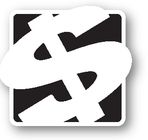CHAPTER 2
How Much Should You Spend?
It seems like you buy my argument that you should buy a house, because you’re still reading. Excellent! Settled and secure? It’s time. Now, how much can you afford to spend on a house? The way the mortgage industry answers this crucial question is with a mathematical formula based on a percentage of your income. I think vague, theoretical formulas like that get people into trouble. I’m going to show you a better way that’s rooted in real life.
Want to know how much you can really afford to spend? Simple. Spend the same amount on your monthly mortgage payment that you currently spend on your rent payment. You may call me crazy, but you’ll see that it’s possible once you read my “Four Walls of Home Ownership,” a four-part plan for saving, affording, maintaining, and paying your home off early. Once you know how much you can spend, it’s time to find a house, and if you buy below your means you will SAVE BIG.
In this chapter, learn to SAVE BIG by:
• Ignoring what the mortgage industry says you can afford.
• Saving up an old-fashioned 20 percent down payment in a special house savings account.
• Making your mortgage payment equal your rent payment.
• Converting your house savings account into a house maintenance account.
• Stooping instead of stretching for a house.
Figuring Out What You Can Afford
When you’re trying to figure out what you can afford to spend on a house, don’t let a real estate agent or mortgage broker set your budget for you. After all, they are paid on commission, and the more you spend, the more they make. Not that they’re dishonest, but they have skin in the game. Plus the entire mortgage industry goes about this the wrong way. They use vague formulas that aren’t based on real life. Let’s take a look.
The Wrong Way
During the real estate boom, most mortgage lenders were approving people for loans if their debts added up to 40 to 45 percent of their incomes. In their calculation, debt includes housing payment, property taxes, homeowner’s insurance, auto financing, student loans, and credit card payments. Income means your monthly pretax income, before Uncle Sam takes a cut. This calculation is called DTI, your debt to income ratio. And I can tell you right now, 40 to 45 percent is too high. Worse yet, some banks were lending to people who had a DTI of 50 to 55 percent. That’s outrageous!
Cancel Cable and Have More Money for Your House!
According to Consumers Union, the average American pays $720 a year for cable. That’s way too much. If you’re trying to save for a home, pull the plug on cable. You’ll still be able to watch your favorite shows. Most broadcast networks offer their shows on their websites soon after they’re shown over the airwaves. At
www.Hulu.com you can find thousands of episodes of hundreds of shows—all free. And the website
www.CancelCable.com has a show-finder tool that helps you find a way to watch your favorite shows some way, somehow.
If your debts are eating up 55 percent of your paycheck and income taxes are eating up another 4 percent or more, you have to wonder what’s left? Actually, you don’t have to wonder. I’ll do the math for you.
Let’s take a look at the case of Katherine and Calvin D. in Kansas who make a gross income of $50,000 a year, which is $4,166 a month. Here’s how their monthly income would look with a 55 percent debt to income ratio and income taxes in line with their tax bracket:
 Irresponsible 55 Percent Debt-to-Income Ratio
Irresponsible 55 Percent Debt-to-Income Ratio| Monthly income | $ 4,166 |
| Monthly taxes | 164 |
| Monthly debt | 2,291 |
| Money left = | $ 1,711/ month |
By allowing nice people like Katherine and Calvin to take on oversized mortgages, lenders were leaving them just $1,711 a month (or $395 a week) to pay for everything else—child care, groceries, gas, parking, vehicle registration, home maintenance, heat, water, telephone, retirement savings, life insurance, clothing, hair-cuts, entertainment, and so on. That’s just $56 a day, obviously not enough money to support a family of four. That’s why you don’t want the modern mortgage industry determining what you can afford to spend on a house.
The 28/36 Rule Back in the old days—the 1990s and before—bankers used a somewhat better formula called the 28/36 rule. It sounds almost quaint now, but here it is. Lenders used to require that your monthly housing related expenses (mortgage, property taxes, homeowner’s insurance) be no more than 28 percent of your monthly pretax income. As an additional safeguard, they also insisted that your total housing costs plus long-term debt (car loans, student loans, alimony, credit cards, medical bills) should be no more than 36 percent of your monthly pretax income.
The 28/36 rule is a much healthier one, but I’m still not a fan of formulas. Formulas are cold, hard numbers that just don’t take into account all the hot, sticky situations that human beings get themselves into.
Using the 28/36 rule now, here’s how much money Katherine and Calvin would have left each month after they pay their mortgage:
 Reasonable 28 Percent Debt-to-Income Ratio
Reasonable 28 Percent Debt-to-Income Ratio| Monthly income | $ 4,166 |
| Monthly taxes | 164 |
| Monthly housing | 1,166 |
| Money left = | $ 2,836/month |
That’s more like it. By following this more old-fashioned formula, they are left with $2,836 a month to pay living expenses for their family of four.
I suggest you commit even less than 28 percent of your income to your housing costs if possible. I encourage you to take a hard look at whether you have any unique expenses that are not included in these standard formulas. Do you spend money to care for an elderly relative? Does one parent want the flexibility to stay home with the kids someday? Did you attend a prestigious but pricey college, leaving you with high student loan payoffs? The 28/36 rule is inadequate. It’s just a starting point. I know a better way. Keep reading!
Dial for Dollars to Save More Money for Your House
Most people spend more than they need to on phone services. Craig, Amy, and Linnea S. of Illinois were spending $3,252 a year for three cell phones. They are super savers, so they paid the website
www.MyValidas.com $5 to analyze their calling patterns and found they could save $1,936 a year by switching to a plan that fit them better! Many people are ditching their landlines, but if you don’t want to rely totally on a cell phone, try Skype. A typical landline phone bill with a traditional phone company is $540 a year. Skype charges about $36 a year!
A Better Way
Here’s a better way to figure out what you can afford. My method is based on real life. If you currently pay rent, buy a house with mortgage payments the same size as your rent payments. That’s my formula. Complex, huh? If you can afford your rent payments, you will be able to afford your house payments. It’s that simple. Don’t believe it’s possible? I’ve got a four-part plan to make it happen. I call it “The Four Walls of Home Ownership.”
The Four Walls of Home Ownership
Houses need four walls to stand, right? Your financial foundation for home ownership needs to be strong, too. When you have all four of these walls in place, they will be a sound financial structure for the sturdy house you hope to buy.
Wall 1: Down payment = 20 percent or more. For the first wall, you save up a substantial down payment of 20 percent or more in a house savings account. Stretch and strain for this sizable down payment because it’s the key to everything.
Wall 2: Rent amount = Mortgage amount. The next wall is making your mortgage payment equal your rent payment. That mortgage payment must include principal, interest, taxes, homeowner’s insurance (PITI), and condo fees, if applicable.
Wall 3: House savings account = Maintenance account. Wall number three is converting your house savings account into a house maintenance account to pay for repairs. You’re already accustomed to saving this money so it’s a painless transition.
Wall 4: Tax deduction = Mortgage prepayment fund. The final wall of your sound financial structure is using the “free money” you get from your mortgage interest tax deduction to prepay your mortgage, saving thousands and paying the loan off years early.
I’m sure you have a lot of questions about how to build your Four Walls of Home Ownership, so allow me to explain in more detail.
Wall 1: Down Payment = 20 Percent or More I urge you to save up a full 20 percent down payment. Those sudsy zero-down loans they were handing out during the bubble years have dried up. They were a bad idea anyway. Why 20 percent? Because that’s the amount that helps you SAVE BIG. If you don’t make at least a 20 percent down payment, you’re going to have to pay private mortgage insurance (PMI). PMI is insurance that covers the lender’s loss if you stop paying your mortgage. It’s not for your benefit at all.
PMI is a big bore and a bad deal. It costs about $150 a month on a $200,000 mortgage. At one time there were creative mortgages you could get to avoid PMI, but they are gone, too. You don’t get to stop paying PMI until you have at least 22 percent equity in your home. Let’s say that takes 10 years to achieve. Here’s how much you can save by avoiding PMI:
 Avoiding Private Mortgage Insurance
Avoiding Private Mortgage Insurance| Mortgage cost over 10 years with PMI | $ 161,880 |
| Mortgage cost over 10 years without PMI | 143,880 |
| BIG SAVINGS = | $ 18, 000 |
You can save $18,000 by avoiding PMI. That’s why you want to make a fat 20 percent down payment. There’s also a more profound reason: Saving a substantial down payment is how you prove to yourself that you’re ready for home ownership. Suze Orman makes this point early and often and she’s absolutely right. Here’s how she puts it in her 2009 Action Plan book: “If you can’t afford to make a down payment, it’s a sign you can’t afford a home.” How are you going to accumulate the money for it? Read on.
Help for Home Buyers
Check out first-time homebuyer assistance programs offered in most every state. They may be able to help you afford a home faster, by helping with your down payment or closing costs or mortgage rate. And the funny thing is
first-time homebuyer is defined very loosely. If you haven’t owned a home in three years, many of these programs consider you a first-timer. Kinda reminds me of a couple I know who vowed not to have sex for six months leading up to their wedding, so they could be “born again virgins.” But I digress—
big time. Whew. Here’s a website with information about state first-time homebuyer programs:
www.ncsha.org.
When I was a little girl, I desperately wanted a horse. I was so horse crazy that when westerns came on TV, I would go sit on top of the television and try to ride it. My parents made me get a goldfish first. Then doves. Then a dog. I was learning responsibility and all the while saving up for a horse in a special account. Finally, my parents said it was time. We split the $500 cost of a sweet, sway-backed mare named Sheba. I hated waiting, but I have to admit, I was finally ready for the early-morning feedings and other hard work.
Substitute your house for my horse and you get the idea. You don’t even have to suffer through cleaning a goldfish bowl. Just open a special house savings account and stash cash in it to prove to yourself that you are ready for home ownership. Have part of your paycheck automatically deposited into this account so your greedy little hands never touch it. Maybe you’re more disciplined than me, but I have found direct deposit into a savings account is the key technique that helps me save.
If you get a raise, sock that money into the savings account, too. I’m not into suffering. It’s all about making changes that feel painless. Since you’re not used to having the extra money from your raise, pretend you don’t. Put it toward the house. Throughout this chapter there are BIG SECRETS with additional sources of savings you can put into your special house account. It’s essential that this account be segregated from all your other bank accounts, because it is uniquely important. Buying a house is your number one way to SAVE BIG.
You may be wondering how you’ll know if you’ve saved enough. When your down payment is big enough that your monthly payments can be the same as your rent payments, you’re ready to buy. Read on for more about the monthly payment part of the plan.
Wall 2: Rent Amount = Mortgage Amount Buying a house at a price point where your monthly mortgage amount can equal your monthly rent amount is the Second Wall of Home Ownership. It may sound unlikely that you can own a place for the same cost as renting one, but remember you’ve been stashing cash for a down payment as fast and furiously as you can. That is the crux of the entire plan. The higher that down payment, the lower your monthly payment.
Here’s an example. Patrick and Jen M. of Illinois pay $1,000 a month in rent, which is close to the median cost of a rental nationwide, according to the U.S. Census. They also have $36,000 saved up to cover their down payment and closing costs. This young couple has been moving from rental to rental as they wound their way through graduate school—and they’re tired of it. Can Patrick and Jen finally afford to buy a home?
Let’s find out. If they use $33,000 of their savings as a 20 percent down payment, they can buy a home for $165,000. They will have $3,000 left over to pay their closing costs. Their loan amount will be $132,000 with an interest rate of 5.5 percent, the average rate as I write this, according to
www.Bankrate.com.
 How Monthly Rent Can Translate to Monthly Mortgage
How Monthly Rent Can Translate to Monthly Mortgage| Patrick and Jen’s Resources | | Patrick and Jen’s Mortgage |
|---|
| Down payment | $33,000 | | Purchase price | $ 165,000 |
| Closing costs | $ 3,000 | Loan amount | $ 132,000 |
| Monthly rent | $ 1,000 | = | Monthly mortgage | $ 1,000 |
As you can see, Patrick and Jen’s monthly mortgage (principal, interest, taxes, and insurance) will equal their monthly rent: $1,000. All because they have diligently saved a healthy, hefty 20 percent down payment, plus extra for closing costs. I’ll say it again: The higher your down payment, the lower your monthly payment.
New Homes Can Make You Feel Used
It’s often riskier to buy a brand-new home than an existing home. It takes a while to work the bugs out of new construction. Other considerations: If you’re one of the first buyers in a new subdivision, there’s a chance the developer will go under before it completes the neighborhood, leaving you in a half-built wasteland. On the flip side, if you go to sell your house in a couple of years, you may be in competition with brand-new houses the developer is still constructing. Why would buyers choose your house when they can customize a brand-new one to their tastes? Finally, new neighborhoods haven’t had time to establish a true value yet. It’s easier to determine the appropriate price of an older, existing home so you don’t overpay.
You may be thinking that not everybody pays $1,000 in rent each month, so how can this advice be sound? Converting rent amount to mortgage amount works because where rents are higher, home prices are higher, too. For example, rental prices are higher in New York City as are home prices. Purchase prices are lower in North Carolina, but so are rental prices. The two don’t move precisely in tandem, but close enough.
Wall 3: House Savings Account = Maintenance Account The Third Wall of Home Ownership is converting your house savings account into a house maintenance account. Remember how you set up a house savings account to save for your down payment? Since you’ve made your mortgage equal your rent, your monthly outlay remains the same. That means you will be able to keep putting the same amount of money into this account each month. You will now use that pot of money to pay for maintenance. You’re used to setting aside this money, so it should be painless. Painless is my goal.
Everybody always preaches about the importance of having a home maintenance fund. They’re right. The most common rule of thumb is that each year you should save 1 percent of your home’s purchase price for maintenance. On a $250,000 house that would be $2,500. Since you’ve been saving so aggressively for your down payment, you are covered. When the furnace goes cold or the air conditioner burns up, you’ll be ready.
Wall 4: Tax Deduction = Mortgage Prepayment Fund The Fourth Wall of Home Ownership is using your tax deduction to prepay your mortgage. The IRS allows you to deduct the interest you pay on your mortgage from your federal income taxes. Many people use this windfall to stretch for a more expensive house. Instead, I want you to use it to pay your mortgage off early. Do so and you will SAVE BIG. Really BIG. This is such an exciting savings opportunity that I’ve written an entire chapter about it. You can read the jaw-dropping details in Chapter 9.
So there you have it. My Four Walls of Home Ownership help you save for a house, afford the monthly payments, maintain the place and pay it off early—all so you can SAVE BIG.
Buy a Foreclosed Home
When somebody can’t make their mortgage payments and the bank seizes and sells off their house, it’s rotten for them but a tremendous financial opportunity for you. According to real estate website
www.RealtyTrac.com, foreclosed homes typically sell at a 20 to 40 percent discount. Let’s start with the national average home price of $250,000 and see what happens with even the low-end discount of 20 percent:
 Benefit of Buying a Foreclosed Home
Benefit of Buying a Foreclosed Home| National average home sales price | $ 250,000 |
| Foreclosed house at 20% discount | 200,000 |
| BIG SAVINGS = | $ 50,000 |
Wow, what a bargain! You can save big—$50,000—by buying a foreclosed home. Just be sure to assemble a team of experienced professionals to help you through the headaches involved in purchasing a foreclosed property.
Don’t Stretch for a House
If your rent amount translates into less house than you were hoping for, suck it up. Seriously. It’s much easier to adjust your housing aspirations to your budget than the other way around. You can choose a cheaper house. You can’t necessarily make more money. Perhaps your first home will have to be a modest one. I recommend it. It’s less stressful. Buy a condo instead of a townhouse, a townhouse instead of a single family home. If you’re gutsy, buy in an emerging neighborhood that is just starting to be rediscovered. You’ll probably have even more profit potential.
I’m sure you’ve heard the advice to stretch for the best house you can afford. You can easily guess that I am against that thinking. Yes, I want you to find a house that will delight you when you come home to it, but I don’t want you to come home and cringe when you pass the pile of bills on the front hall table. As far as I’m concerned, the right house is one below your means. Don’t stretch for a house. Stoop for a house!
In her book 50 Simple Things You Can Do to Improve Your Personal Finances, syndicated columnist Ilyce Glink puts it this way: “Buy the smallest, cheapest . . . least fixed up house on a very good block in the best school district you can afford.” I couldn’t agree more. She’s making a few great points about the value—and resale value—of your home. So let’s go over them piece by piece.
• Smallest. McMansions are out. The not-so-big house is in. Don’t pay for more square footage than you will use. How many people have formal living rooms they only set foot in once a year?
• Cheapest. The message here is to buy a house that is inexpensive compared to the ones around it. If you buy the priciest house on the block, the cheap ones drag its value down. Buy the cheapest, and the others will pull your home’s value up.
• Least fixed up. If the house is not fixed up, you can be the one to bring it up to the level of the ones around it. This is a great way to turn a profit, especially if you are handy enough to do some of the work yourself.
• Very good block. By buying on a very good block, you get the enjoyment of living in this great neighborhood, for less than the people around you. And when it’s time to sell, the quality of the block will do wonders for your property value.
• Good school district. Even if you don’t have children, houses in good school districts have a record of going up in value faster. It’s all supply and demand. There will be lots of demand for your house when you sell.
BIG TIPS
• Don’t rely on the mortgage industry to tell you what you can afford.
• Start a special house account to save up a 20 percent down payment.
• Make your mortgage payment equal your rent payment.
• Turn your house savings account into your house maintenance account.
• Use your mortgage interest tax deduction to prepay your mortgage.
• Buy below your means.

 Irresponsible 55 Percent Debt-to-Income Ratio
Irresponsible 55 Percent Debt-to-Income Ratio Reasonable 28 Percent Debt-to-Income Ratio
Reasonable 28 Percent Debt-to-Income Ratio
 Avoiding Private Mortgage Insurance
Avoiding Private Mortgage Insurance
 How Monthly Rent Can Translate to Monthly Mortgage
How Monthly Rent Can Translate to Monthly Mortgage

 Benefit of Buying a Foreclosed Home
Benefit of Buying a Foreclosed Home